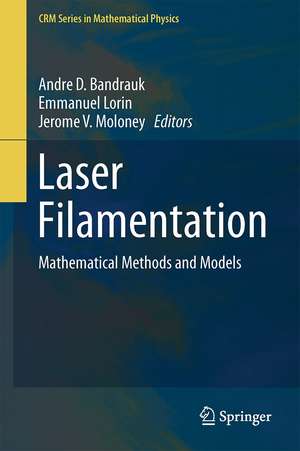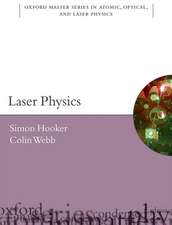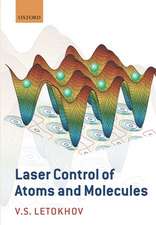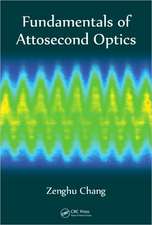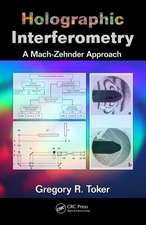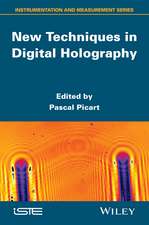Laser Filamentation: Mathematical Methods and Models: CRM Series in Mathematical Physics
Editat de Andre D. Bandrauk, Emmanuel Lorin, Jerome V. Moloneyen Limba Engleză Hardback – 23 oct 2015
The increasing power of high performance computers and the mathematical modelling and simulation of photonic systems has enabled many new areas of research. With contributions by theorists and mathematicians, supplemented by active experimentalists who are experts in the field of nonlinear laser molecule interaction and propagation, Laser Filamentation sheds new light on scientific and industrial applications of modern lasers.
| Toate formatele și edițiile | Preț | Express |
|---|---|---|
| Paperback (1) | 637.13 lei 6-8 săpt. | |
| Springer International Publishing – 23 aug 2016 | 637.13 lei 6-8 săpt. | |
| Hardback (1) | 643.34 lei 6-8 săpt. | |
| Springer International Publishing – 23 oct 2015 | 643.34 lei 6-8 săpt. |
Din seria CRM Series in Mathematical Physics
- 18%
 Preț: 1240.30 lei
Preț: 1240.30 lei - 18%
 Preț: 948.61 lei
Preț: 948.61 lei - 18%
 Preț: 942.01 lei
Preț: 942.01 lei - 15%
 Preț: 648.89 lei
Preț: 648.89 lei - 18%
 Preț: 1249.00 lei
Preț: 1249.00 lei - 15%
 Preț: 604.19 lei
Preț: 604.19 lei - 15%
 Preț: 584.06 lei
Preț: 584.06 lei - 18%
 Preț: 1119.87 lei
Preț: 1119.87 lei - 15%
 Preț: 642.51 lei
Preț: 642.51 lei - 15%
 Preț: 655.78 lei
Preț: 655.78 lei - 18%
 Preț: 960.78 lei
Preț: 960.78 lei -
 Preț: 409.89 lei
Preț: 409.89 lei -
 Preț: 387.38 lei
Preț: 387.38 lei - 15%
 Preț: 654.12 lei
Preț: 654.12 lei - 15%
 Preț: 647.73 lei
Preț: 647.73 lei - 18%
 Preț: 1398.94 lei
Preț: 1398.94 lei
Preț: 643.34 lei
Preț vechi: 756.86 lei
-15% Nou
Puncte Express: 965
Preț estimativ în valută:
123.10€ • 128.87$ • 101.86£
123.10€ • 128.87$ • 101.86£
Carte tipărită la comandă
Livrare economică 05-19 aprilie
Preluare comenzi: 021 569.72.76
Specificații
ISBN-13: 9783319230832
ISBN-10: 3319230832
Pagini: 216
Ilustrații: XII, 216 p.
Dimensiuni: 155 x 235 x 20 mm
Greutate: 0.5 kg
Ediția:1st ed. 2016
Editura: Springer International Publishing
Colecția Springer
Seria CRM Series in Mathematical Physics
Locul publicării:Cham, Switzerland
ISBN-10: 3319230832
Pagini: 216
Ilustrații: XII, 216 p.
Dimensiuni: 155 x 235 x 20 mm
Greutate: 0.5 kg
Ediția:1st ed. 2016
Editura: Springer International Publishing
Colecția Springer
Seria CRM Series in Mathematical Physics
Locul publicării:Cham, Switzerland
Public țintă
ResearchCuprins
Short Pulse Evolution Equation (SPEE).- Variants of the Focusing NLS Equation. Derivation, Justification and Open Problems Related to Filamentation.- Blowing Up Solutions to the Zakharov System for Langmuir Waves.- THz Waveforms and Polarization from Laser Induced Plasmas by Few-Cycle Pulses.- Lasing Actions Inside a Femtosecond Laser Filament in Air.- Filamentation and Pulse Self-Compression in the Anomalous Dispersion Region of Glasses.- Nonperturbative Nonlinear Maxwell–Schrödinger Models for Intense Laser Pulse Propagation.- Numerical Simulation of Ultra-Short Laser Pulses.
Textul de pe ultima copertă
This book is focused on the nonlinear theoretical and mathematical problems associated with ultrafast intense laser pulse propagation in gases and in particular, in air. With the aim of understanding the physics of filamentation in gases, solids, the atmosphere, and even biological tissue, specialists in nonlinear optics and filamentation from both physics and mathematics attempt to rigorously derive and analyze relevant non-perturbative models. Modern laser technology allows the generation of ultrafast (few cycle) laser pulses, with intensities exceeding the internal electric field in atoms and molecules (E=5x109 V/cm or intensity I = 3.5 x 1016 Watts/cm2 ). The interaction of such pulses with atoms and molecules leads to new, highly nonlinear nonperturbative regimes, where new physical phenomena, such as High Harmonic Generation (HHG), occur, and from which the shortest (attosecond - the natural time scale of the electron) pulses have been created. One of the major experimental discoveries in this nonlinear nonperturbative regime, Laser Pulse Filamentation, was observed by Mourou and Braun in 1995, as the propagation of pulses over large distances with narrow and intense cones. This observation has led to intensive investigation in physics and applied mathematics of new effects such as self-transformation of these pulses into white light, intensity clamping, and multiple filamentation, as well as to potential applications to wave guide writing, atmospheric remote sensing, lightning guiding, and military long-range weapons.
The increasing power of high performance computers and the mathematical modelling and simulation of photonic systems has enabled many new areas of research. With contributions by theorists and mathematicians, supplemented by active experimentalists who are experts in the field of nonlinear laser molecule interaction and propagation, Laser Filamentation sheds new light on scientific and industrial applications of modern lasers.
The increasing power of high performance computers and the mathematical modelling and simulation of photonic systems has enabled many new areas of research. With contributions by theorists and mathematicians, supplemented by active experimentalists who are experts in the field of nonlinear laser molecule interaction and propagation, Laser Filamentation sheds new light on scientific and industrial applications of modern lasers.
Caracteristici
Brings together the latest models, theories and experiments Presents models and mathematics of nonlinear optical processes in modern laser technology Describes nonlinear, nonperturbative response of matter to ultrafast intense laser pulses Reviews the physics and applied mathematics of intense laser pulse propagation in materials Covers potential applications to wave guide writing, remote sensing, lightning guiding, and laser-guided medicine
